|
FLUXUS BIRTH.
In 1959-60, in the USA, Dick Higgins organizes "Public
Events" on a box ring on Madison Square. Judson Church (Greenwich
Village) and the E-pit-o-me Coffee Shop are then two special
places for the Events thanks to Alan Kaprow, Georges Brecht,
Al Hansen, La Monte Young, Carolee Schneemann, Dick and Alison
Knowles, Yoko Ono for instance.... All these innovating people
are looking for a name for their group, and Maciunas will give
it as he arrives in 1962 : Fluxus is born. But at the beginning
Fluxus was the name of a periodical. After an european tour (
always in 1962) the press and foreign newspapers will assign
this name to the members of the group since they are the ones
who publish the periodical. There, Dick and Alison meet or find
Chiari, Paik, Vostell, Andersen, Spoerri, Filliou, Ben Vautier,
De Ridder, Patterson, and many more.
The main difference between Fluxus and other iconoclastic trends
such as Futurism, Dadaism or Surrealism, is that Fluxus has never
had to become a trend, a fashion. Maciunas has never had inside
the group the authority that Breton did inside Surrealism. That
is a major fact: that is why Fluxus is harder to define than
most of the other trends.
Dick and la Monte Young are the 2 persons who have introduced
Maciunas, whose formation was rather classical, avant-garde'
like.
Fluxus, art in life. Nam June Paik said: "Fluxus looks like
a Corean plant. It is just when it seems dead that it is about
to flower".
Fluxus physically died when Maciunas did, but Fluxus survives
thanks to those who continue to spread his spirit.
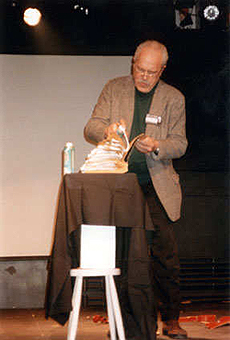
D. Higgins, Art-Action, Québec,1998.
Another important artist close to Fluxus : Jean Dupuy
At the same time, another artist influenced that period:
Jean Dupuy. In 1967, he left France for NYC. He is the witness
of great actions carried out by the artists for better material
conditions and against the war of Viêt-Nam. He decides
to stop painting and devotes himself to the technological Art.
Thanks to " Heart Beats Dust " and " Cone Pyramid
" in 1968, he gains the contest of Experiment in Art and
Technology ". It is the beginning of its American success.
Then, as he lives in large a loft, he invites artists, friends,
to make other proposals. The idea of collective performances
was born. Charlotte Moorman, Nam June Paik, Laurie Anderson,
Claes Oldenburg, Charlemagne Palestine, George Maciunas, Carolee
Schneemann, Joan Jonas, Philip Glass, Olga Adorno, Gordon Matta-Clark,
Richard Serra, will connect short actions controlled by the duration
and sometimes by an imposed device (Whitney Museum, Judson Church).
In the Kitchen, he organizes the evening "Soup and Tart"
where 40 artists make a small action not exceeding 2 minutes.
The state of mind of "Lazy Art" uses the principle
of "laisser-faire" by letting do the works by the others.
Most important according to Dupuy is
" to have fun ". And by chance, Charles Dreyfus helped
him to arrange his loft in 1972 (in company of Philipp Glass).
Jean Dupuy will get along so well with George Maciunas, such
a complicity will link them, that he will inherit his loft at
the death of the latter, not without generating certain jealousies.
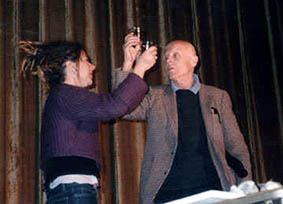
Jean Dupuy and Sylvie Cotton, Festival Full Nelson, USA, 2002.
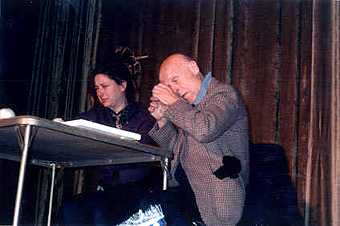
THE IMPORTANCE OF POETS.
No one nowadays would deny the founding and initiative role
of poets in the making of the greatest artistical trends.
Baudelaire linked poetry to the world of art and made the poet
becomes an artist, Rimbaud bounded art to life and Mallarmé
changed the poem into a typographic ballet or into a score-poem.
Avant-garde trends from the beginning of the century have been
created by poets : Futurism by Marinetti, Dada by Tsara and Hausmann
and many others, Merz by Schwitters and Cobra by Dotremont.
Cosmic and galactic space open by Mallarmé's "Coup
de dés" in 1897 is very important for the 20th century
art where are gathered two main notions : "chance"
(hasard)(Mallarmé) and "silence"(John Cage).
Sound poetry.
Numerous writers read aloud their texts in front of a meditative,
admiring audience. These Public Reading have nothing to do with
Sound Poetry.
Listening to the Swiss Vincent Barras, this term established
in the 50's (or changed according to the taste of the time after
that the Dadaïst Hugo Ball, around the beginning of the
century, used the term Laudgedicht or sound poem) specialy refered
to experimentations leaded at the end of the 2nd world war by
diverse pionners of electro-acoustic and concrete music (in France
around Pierre Schaeffer).
Important also are language distroying directed during Dadaïst
evenings of the Cabaret Voltaire, vocal and phonetic experimentation
of creators such as Raoul Hausmann, Michel Seuphor, Pierre-Albert
Birot and Kurt Schwitters and his famous Ursonate. As soon as
the beginning of the 50's, poets all claim themselves as sound
poets.
Sound Poetry is still rarely published by current medias. If
one wanted to choose the favorite medium of Sound Poetry, - it
would be, much more than books, discs or videos recording, -
the body.
In France, Henri Chopin seeks for vocal microparticles, and uses
all the diverse possibilities of the microphone, until entering
one into his stomach. Bernard Heidsiek's action-poems
are real miniature operas. This pioneer
( with Henri Chopin ) of Sound poetry since 1955 uses as soon
as 1959 the tape recorder as another mean of writing and of broadcasting.
Several international sound poets are well known, as the Australians
Amanda Stewart and Chris Mann, the Canadians Paul Dutton, Steve
McCaffery, Mark Sutherland and Nobuo Kubota; in the Nedeerlands,
Jaap Blonk, in Italia Giovanni Fontana, Enzo Minarelli, Nicolas
Frangione, Massimo Arrigoni ; in Hungary, Katalyn Ladik, the
young English Chris Jones and Alistair Noon, the list is over.
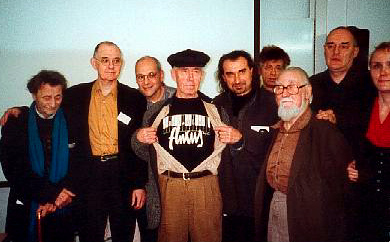 Festival Rethinking the Avant
garde, leicester, 2001. Festival Rethinking the Avant
garde, leicester, 2001.
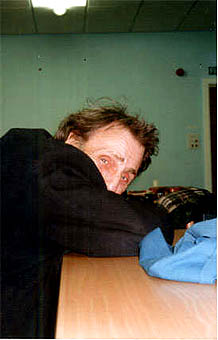 H. Chopin H. Chopin
Action Poetry.
If I had to choose only one, it would be Julien Blaine.
His gestures and his brutal metaphors are free from any constraining
function, and make up meanings and rythms.
And to add another one, I would call the also excellent Joël
Hubaut ,who, with his lack of restrain, his boor-like excesses
and his proliferation shows an exacerbated sensibility.
And so as not to let him aside, I will end with the chaman, Serge
Pey.
Robert Filiou in 1961, with its poem " With 53 kilos poem
" use the word Action Poetry. "
It is not a question of writing a text any more, but an event:
composing its organisation by sounds, objects, silences, gestures,
breaths and texts which are the raw materials of the poem and
its extension " (Jean-Noel Orenco, Hundred Titles).
Michel Métail, Jean-François Bory in France , Bartolomeo
Ferrando in Spain, Bianca Menna, Arrigo Lorra-Tottino in Italy,
Fernando Aguiar in Portugal, the list here also would be very
long. Once again, all my excuses with the absent ones!
It is necessary to also mention the rising generation of poets,
supported by Laurent Cauwet and Al Dante editions and largely
applauded by Bernard Heidsieck. The latter bring to the poetic
scene the necessary oxygen puff, and the young poets take over
with poetry computer made up by Jacques Donguy, Philippe Castellin,
Tibor Papp, Claude Maillard, the skinned poems of Katy Molnar,
the prose of Christophe Tarkos, and those of the review Java,
Vanina Maestri, Jacques Sivan and Jean-Michel Espitallier. Among
them, Christophe Hanna, Christophe FIAT, Nathalie Quintane, Stéphane
Bérard, Laure Limongi, Anne-James Chaton, Manual Joseph,
Olivier Quintyn, Daniel Foucard, Eric Arlix, Jérome Gontier,
Thibaud Baldacci.
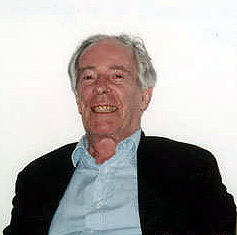 B. Heidsieck B. Heidsieck
The recent disappearance of the theorist and professor Nicholas
Zurbrugg in October 2001 left a great vacuum in the performative
and poetic areas which he defended and supported with the talent
and enthusiasm that we know to him. His great knowledge in this
field had inspired many publications and the creation of the
Festival " Rethinking the Avant-Garde" at the University
De Montfort, England, where he taught. His knowledge of the Australian
continent where he had spent 17 years contributed to give this
insatiable pioneer, curiosity necessary to the analysis of the
varied influences representative of our time. His great originality,
his sensitivity, his humour, and especially his generosity except
standard let to all those which knew him the nostalgic memory
of this delicious and unique man.
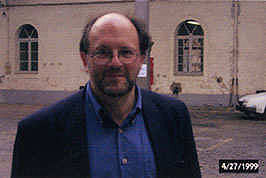 N. Zurbrugg N. Zurbrugg

|
|